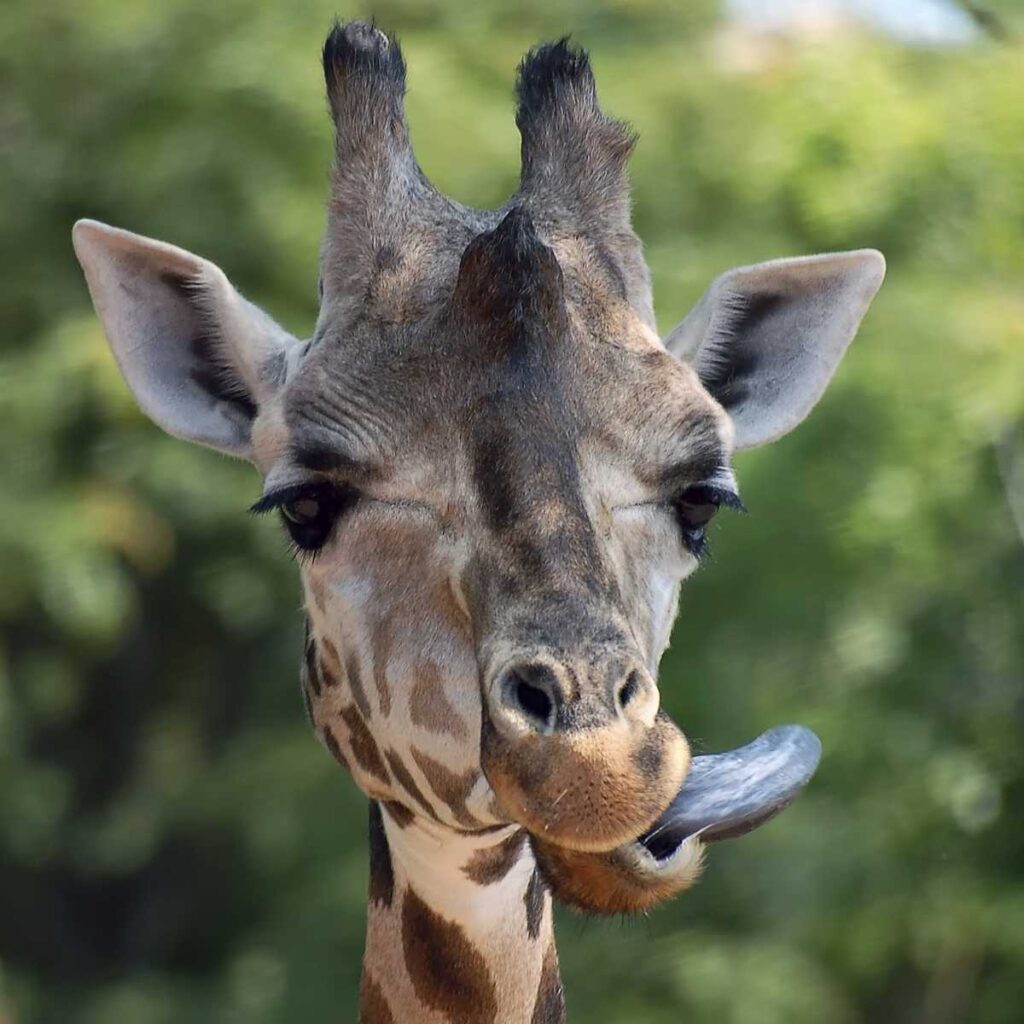Last Reviewed and Updated on June 16, 2022
Their long necks along with their sleek bodies and cool fur patterns make giraffes one of the most recognizable animals on our planet. But that’s not all, there are many more interesting facts about giraffes that make these mammals stand out from other animals.
Ready to learn some? Here we go!

1. Giraffes are the tallest living land animal
The tallest of the giraffe species is the Masai giraffe (Giraffa camelopardalis tippelskirchi). No other animal comes close, even the elephant, the largest land animal, is far behind.
2. Combat between male giraffes is called necking
Male giraffes will go neck to neck to establish dominance. Neck-to-neck combat! They will swing their necks at each other, and their thick skulls are even capable of crushing vertebrates. While not common, a fight can even end in the death of a giraffe.

3. Giraffes have horn-like structures on their head called ossicones
These are bone structures covered with skin and fur. Giraffes are one of the two living species that have this feature, the other one being okapi, a close relative of giraffes.
They serve a similar purpose as horns do with other animals, they use them as weapons during combat.
Both female and male giraffes have them.

4. They have a wide field of vision
Their eyes are located on the sides of their head and they are bulged out slightly. This gives them excellent peripheral vision, making them more alert to any predators.
5. Giraffes have long tongues
The tongue of an adult giraffe is about 18 inches / 45 cm long. The tongue is adapted for grasping foliage. Its length also allows the giraffes to reach foliage that is located higher on the trees.
6. Fun giraffe fact: their tongues are dark, almost black
Their tongues are dark, the assumption is this is to protect the tongue from sunburn.

7. They are missing front teeth on their upper jaw
Giraffes have 32 teeth, just like us, but have none in the upper front jaw. They have strong lips though, which they use to grab leaves and twigs.
8. Their necks can be 7.9ft / 2.4m long
They have the longest neck of all mammals. Darwin’s theory was that their necks elongated as they evolved due to giraffe specimens with longer necks having better access to leaves on top of trees.
9. Giraffes have four-chambered stomachs
Like cows, sheep, and deer, giraffes also have more than one stomach. Animals with more than one stomach are called ruminants.
10. They have strong hearts
Compared to many other animals the giraffe’s heart is rather large (2 feet / 0.6 meters) and heavy (11 kg). However, if you look at the size of the heart in relation to the size of the animal, their hearts aren’t all that different from many other mammals as far as the size goes, in fact, they are even smaller.
But the long necks of the giraffe and their size overall makes it harder for the heart to pump blood towards the head, and a normal heart just would not cut it. They have incredibly strong heart muscles, the left ventricle has really thick walls so their heartbeats are very strong.
11. Giraffes have the same number of neck vertebrae as humans do
This is one of the most surprising facts about giraffes, given the length of their necks. They actually have very few vertebrae – in fact, they only have 7 (some argue 8). Their vertebrae are very long though.
12. They live in groups of different sizes
Giraffes are quite social and live in groups. Most groups have around 10 to 20 individuals, but they can have a fewer number of members or a lot larger.
13. Why call them giraffes if you can call them camelopard
This is a more archaic English expression for a giraffe and it derives from a Greek word for camel and leopard. It makes sense, right.
14. Other animals use giraffes to pick up on signs of approaching danger
As giraffes have excellent peripheral vision and the advantage of height they are very good at spotting potential danger. Zebras have learned to read the body language of giraffes and they can recognize when giraffes sense danger. One of the most fascinating facts about giraffes? We think so!
15. Adult giraffes generally have no predators
Survival rates of adult giraffes are high. They make difficult prey due to their size, their alertness, and their strong deadly kicks. They are also very fast, which can help them escape predators. Lions and crocodiles hunt them but will do so only if other options are scarce.
Young giraffes are fair play for predators, although predators have to avoid adult giraffes protecting their young.
16. Giraffes can babysit offspring of other giraffes
This one is the sweetest out of all facts about giraffes. They care for their young, and even the young of other giraffes for short periods of time. A giraffe can leave her offspring with another giraffe while she goes about.
17. Female giraffes are called cows and male giraffes are called bulls
A baby giraffe is called a calf.
18. A group of giraffes is called a tower
Such a fitting name for a group of these animals.
19. And here is an odd fact about giraffes: males check the fertility of females
Talk about an odd giraffe fact. A male giraffe will nudge the rear end of the female giraffe to encourage urinating and he will then taste the urine. By tasting the urine, the male can determine if the female giraffe is fertile and ready for mating.
